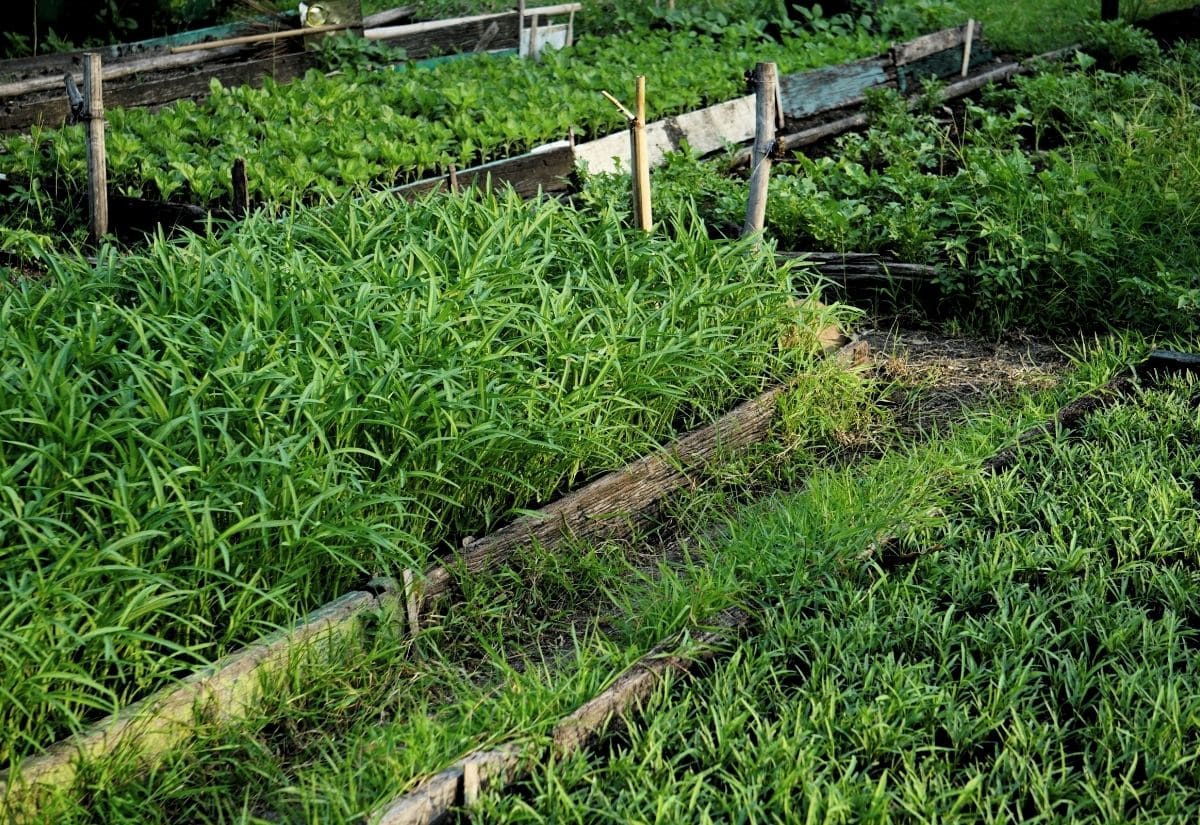
Raised beds are wonders in the garden: they warm early in the spring, have good drainage, and are filled with rich fertile soil… at least for the first few years. So what should you do in the winter to protect your beds when the garden season is done, or how can you keep the soil rich and fertile between fall and spring plantings? Try growing a cover crop!
Cover crops are any grains, brassicas, grasses, or legumes grown in your beds to improve the health of the soil by being cut down as a mulch, tilled in as a “green manure”, or winterkilled for off-season protection.
Among their most prominent benefits, cover crops will build the soil with organic matter, attract good bugs and organisms, prevent erosion, and create a vibrant, fertile growing environment for your raised bed garden over the winter before spring planting.
We’ve experimented with various combinations, including cover crop seed mixes. Nowadays, we primarily plant winter rye, winter wheat, buckwheat, or oats in our garden. It’s essential to note that picking the perfect cover crop isn’t just about following trends; it’s about understanding your raised bed’s specific needs, regional climate, and the crop you intend to plant in the spring.
Why Should You Plant Cover Crop Seeds In your Raised Beds
Whether you have used raised beds for years or are just starting a raised bed garden, growing cover crops are one of the best ways to keep the soil healthy and fertile.
Cover crops are sometimes called a living mulch, and are plants that you do not grow to harvest, but instead use them to build the soil. Depending on the needs of your raised bed, cover crops will:
- Prevent erosion by covering bare soil
- Food for soil organisms and earthworms
- Keep nutrients from being washed away
- Loosen subsoil with deep roots
- Loosen and aerate Soil
- Improve drainage
- Provide shelter for overwintering critters (good insects and microorganisms)
- Break insect and disease cycles
- Create biodiversity
- Fix atmospheric nitrogen with legumes
- Choke out weeds by smothering or producing allelopathic chemicals
- Improve fertility by adding nutrients
- Add organic matter
- Hold moisture in the soil
- Attracts beneficial insects like pollinators and predatory insects
Best Time for Planting a Cover Crops in Your Home Garden
It is important to time the planting of cover crops so they are the right size and maturity for when you need them.
There are three main times to plant cover crops:
How To Plant Cover Crops In Raised Beds
You can plant cover crops amongst your growing vegetables, or they can be included as part of your crop rotation.
Lightly broadcast the seeds, or sow them in lines depending on how thin you want the planting to be. Most cover crops do best when sown shallowly, around 5mm to 6mm (1/4 inch), so you can gently tamp the seeds down, lightly rake the area, or sprinkle top soil on top to keep them from being planted too deep.
Keep the seeded area evenly moist until germination, then continue to water them regularly as you do the rest of the garden.
How To “Harvest” Raised-Bed Cover Crops
In truth, we don’t really harvest cover crops, but we grow them to kill them off. We let them die in the cold, or we till them into the ground or cut them off to compost them. Here are the most common ways to use cover crops:
In most cases, you want to till or cut the cover crops before their seed heads mature and produce seeds. The ideal stage for tilling under or mowing is when the plant is 50% to 80% in bloom.
For some grain crops, like wheat, rye, or buckwheat, I’ve let them mature and even harvested the grain.
However, once the seed heads mature, the roots become more robust and are trickier to till. Moreover, the leftover plant foliage offers fewer nutrients when tilled or mown compared to when the plant is still green.
Types Of Cover Crops For Raised Garden Beds
Cover crops are roughly divided into three main groups:
Broadleaved cover crops include buckwheat, sorghum, and the like. They grow fast and suppress weeds well.
Grains like wheat, oats, or rye, are excellent to loosen soil compaction, and they grow well in most soils and conditions.
Legumes have dense, rich foliage and fix atmospheric nitrogen into the soil. Certain bacteria, called Rhizobia, infect the roots of legumes and form nodules, or little bumps on the roots. The Rhizobia feed on proteins and carbohydrates taken from the legume, and in return they take atmospheric nitrogen (which is unusable to plants) and converts it into readily available ammonium for the benefit of their host.
Some cover crops are perennial, which are excellent for establishing a weed-suppressant mat around your plants that comes back to flower each year, though most cover crops are annuals for a fast growing soil builder than can be quickly incorporated into the raised bed.
TIP: One great advantage of a raised bed is that they can be built anywhere on any surface. Many cover crops have a deep tap root that helps loosen compacted soil, so be careful of your cover crop’s root depth if your raised bed has a solid base.
10 Best Cover Crops To Use In Raised Beds
Below are our preferred cover crops to grow in raised beds, and don’t be afraid to mix and match for a really beneficial blend:
1: Buckwheat

Buckwheat is a popular choice as a cover crop for raised beds. It acts as a superb green manure, growing rapidly, sometimes reaching heights of up to 1.5m (5 feet) before it starts to bloom. Its dense foliage contributes a significant amount of organic matter to the soil. Additionally, buckwheat absorbs nutrients that many plants can’t reach, releasing them in easily accessible forms once it’s tilled back into the soil. Ideally, for maximum soil benefit, it’s best to till buckwheat about 10 days after it blooms, but this can be done anytime.
Beyond soil benefits, buckwheat produces beautiful white flowers that attract pollinators and helpful predatory insects. As a bonus, if you don’t get around to tilling them before they mature, you can harvest the edible seeds before turning under the coarse stems.
Buckwheat is also an excellent weed suppressor. The foliage will shade and smother out the weeds, and the plant will release allelopathic chemicals which will inhibit weed seed germination. This allelopathic nature will also inhibit the germination of your own seeds, so make sure to plant buckwheat after your plants are already up, and wait 2 weeks after tilling before sowing a new crop.
When it comes to sowing, I’ve had the best results planting seeds about 2cm to 4cm (1 to 1½ inches) deep. Its rapid growth has allowed me to sow multiple batches across the growing season. However, a lesson learned the hard way: buckwheat doesn’t survive frost. So, I make sure my final sowing is done well before the anticipated fall frost, usually a month in advance.
2: Crimson Clover

There are many kinds of clover, but crimson clover is one of my favorite flowering cover crop to plant in my raised beds. Effective both in fields and raised beds, and it fixes nitrogen like all legumes.
This is a hardy annual variety that can survive down to Zone 6 (-23°C/-10°F) though it has come back in our Zone 2 garden. Sow the seeds shallow around 5mm (1/4 inch) deep and it prefers well-drained soil with a neutral pH for it to grow quickly. Because it is so hardy, it can be planted any time from spring to fall, depending on the needs of your bed.
crimson clover’s dense growth makes a great mulch to cover weeds and adds lots of organic matter when tilled under. Its pretty, sweet smelling flowers attract lots of good bugs, and make sure to till them in before going to seed or it becomes very tough. They are easy to dig in and usually only take 10 days to decompose so you can plant right away, but avoid following them with other legumes like peas or beans.
3: White Dutch Clover
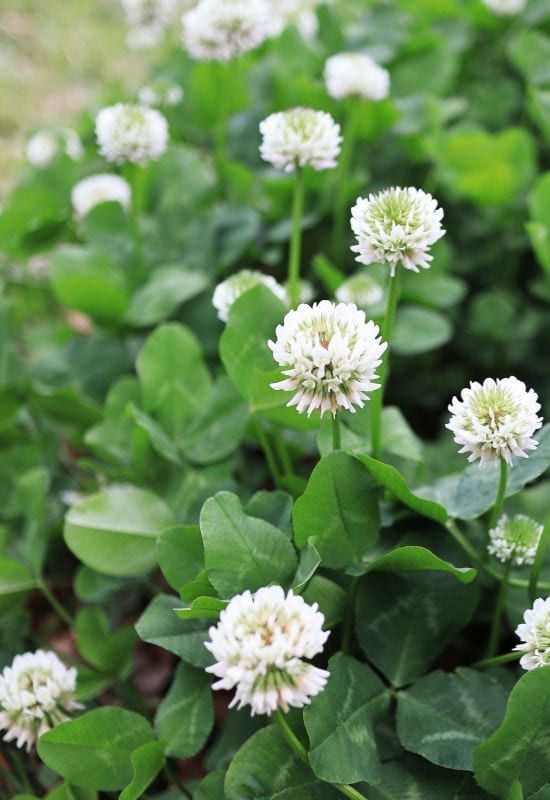
If you want a perennial cover crop in your raised bed, White Dutch clover is a great option and it will safely overwinter down to Zone 4 (-34°C/-29°F) though we have it return in our Zone 2 under an insulating layer of snow.
White Dutch clover can be used as a long term ground cover and it can withstand foot traffic so it is excellent for oaths or between heavily trodden rows.
It fixes nitrogen, adds plenty of organic matter (it works well to mow it and add them cutting to your compost), loosens and builds the soil, and attracts beneficial insects.
It is grown similarly to crimson clover, but it does not germinate in dry periods well, so sow it in spring or late summer and early fall. It spreads by underground runners and forms a dense root mass which is excellent to prevent erosion. It is slightly harder to till under, so it is a little tricker for raised beds where intense tilling isn’t an option, so plan on making the most of its perennial nature.
4: Peas
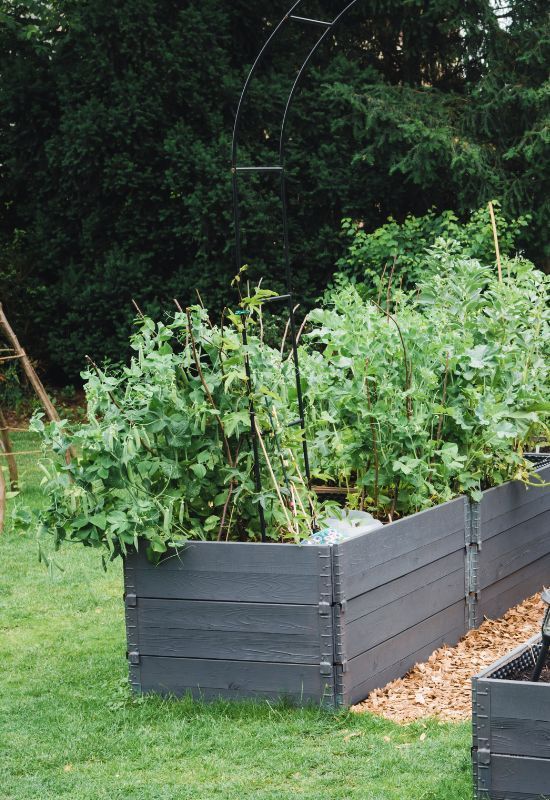
Perhaps one of the easiest garden vegetables to grow, peas also make an excellent cover crop. They are nitrogen fixers and add copious amounts of organic matter.
It might seem like a shame to till under such a prodigious crop, but they add copious amounts of organic matter. They also fix nitrogen and the flowers attract lots of pollinators and good predatory insects. For best results, till the plants under before seed pods are produced, because nitrogen fixation decreases after this.
If you grow a vining variety, the vines can be grown along the ground and act as a weed-suppressing, moisture-preserving mulch.
Peas to not handle the heat of summer very well, but their frost-hardy nature means they can be planted in early spring or later in the year.
5: Radishes
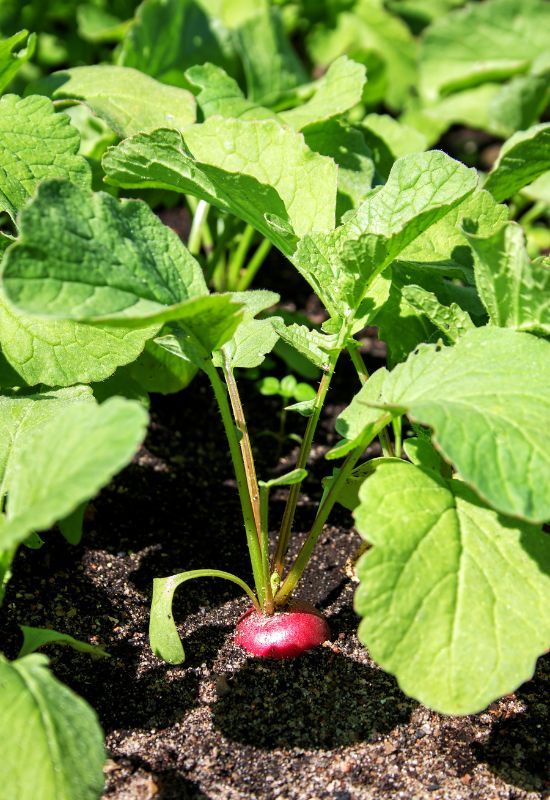
Another common vegetable that is insanely easy to grow and these are one of my favorite crops for raised beds. Most of us harvest radishes for the edible roots so we never see the plants in all their glory and there are a number of reasons to let radishes grow.
Radish plants are huge and add lots of organic matter when tilled under. The large plants also smother and shade out weeds in your raised beds. They produce clusters of beautiful pink and white flowers which attract pollinators (hummingbirds are also attracted by the sweet smelling flowers). The plants can be tilled in when they are lush and green, or you can let them mature and they will produce edible seed pods. The pods are nice and crisp with a mild radish flavor and I actually prefer eating the pods over the roots themselves.
Radishes grow very quickly so they can be planted throughout the growing season, though summer sown ones probably won’t be very tasty. Sow radishes according to the package direction. You can harvest every second one for eating and leave the rest to continue to grow as a cover crop.
6: Alyssum

Alyssum is a popular cover crop for many gardeners, and they do very nicely in raised beds. They are hardy to Zone 3 (-40°C/-40°F), but are mostly grown as an annual. They grow quickly, smother weeds, and are one of best cover crops for attracting predatory insects and pollinators.
Even though they are not usually grown as a soil builder, they will still add organic matter when tilled under, or they can be cut down and added to the compost.
Avoid sowing Alyssum in the heat of summer, so plant them from spring to early summer or from late summer to early fall. Alyssum seeds need sunlight to germinate so sprinkle the seeds on the surface of the soil.
7: Fall Rye

If you want ultimate winter protection, grow fall rye in your raised bed.
Fall rye has dense roots that helps soil texture, improves drainage, and prevents erosion over winter. In the spring, till fall rye under once the lush green growth reaches 30cm (12 inches) to add lots of fertility before planting. If left to mature it will add plenty of carbon-rich matter.
Fall rye is allelopathic, so allow it to decompose for three weeks prior to planting so it won’t interfere with the germination of your crops.
I typically sow fall rye seeds in late summer or early September, but you can also plant them 6-8 weeks before the first frost date. Once winter sets in, fall rye goes dormant. It is cold hardy to Zone 3 (-40°C/-40°F), and it will burst forth in the spring. When I sow the seeds, I plant them 2cm to 4cm (1-1.5 inch) deep to achieve optimal results, and they will grow in a wide variety of soil types.
8: Oats

Oats grow very quickly, making them very easy to fit in with your raised bed crop rotation. They can be tilled under within a few weeks of germination to add lush green organic matter. Or, you can let them mature to harvest the grain, and then use the remaining “straw” as an organic mulch or add carbon-rich organic matter.
Sow oats 2cm to 4cm (1-1.5 inch) deep. For best results, plant them in the spring to till under, or sow them in late summer and let them die for winter protection.
Oats are only hardy to Zone 8 (-12°C/-10°F) so they are usually grown as an annual, but the roots and dead stalks will protect the soil in your bed over winter.
Allow the plants to decompose for two weeks before planting in the bed.
Wheat is grown much the same, and is an excellent alternative to oats.
9: Barley
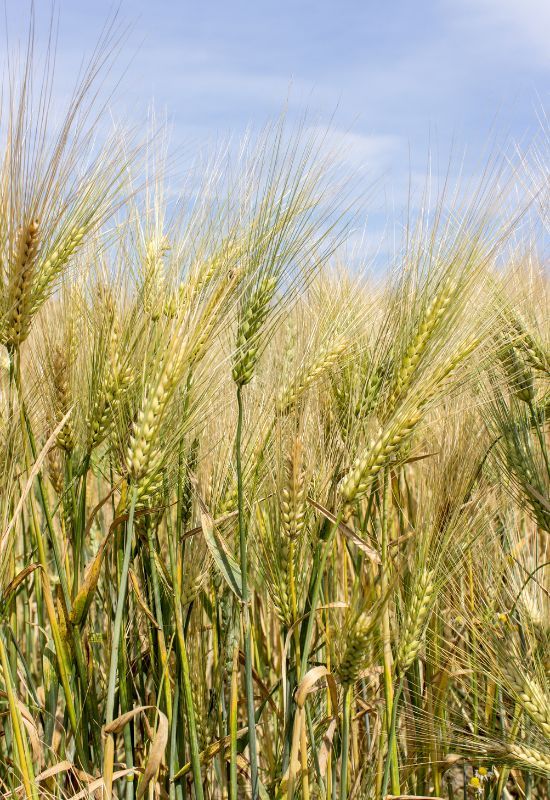
The dense, fibrous roots of barley can reach 2m (6 feet) deep. Barley is perfect for loosening compacted soil in the beds, and provides excellent erosion control. Loosen compacted soil.
TIP: Make sure the bottom of your raised bed can handle the deep digging roots of barley.
Barley is another fast growing annual, and it will winterkill at only -8°C (17°F). When tilled under, barley is high in nitrogen when it is still green, or rich in carbon when it is dry. Allow about 2 weeks to decompose before planting another crop. Otherwise, its deep roots and “straw” provide good winter protection
Sow barley like oats or rye, and it can be planted all growing season long. If you want to harvest the grain, sow it in the spring and then leave stalks for carbon rich organic matter and roots for erosion control.
10: Mustard
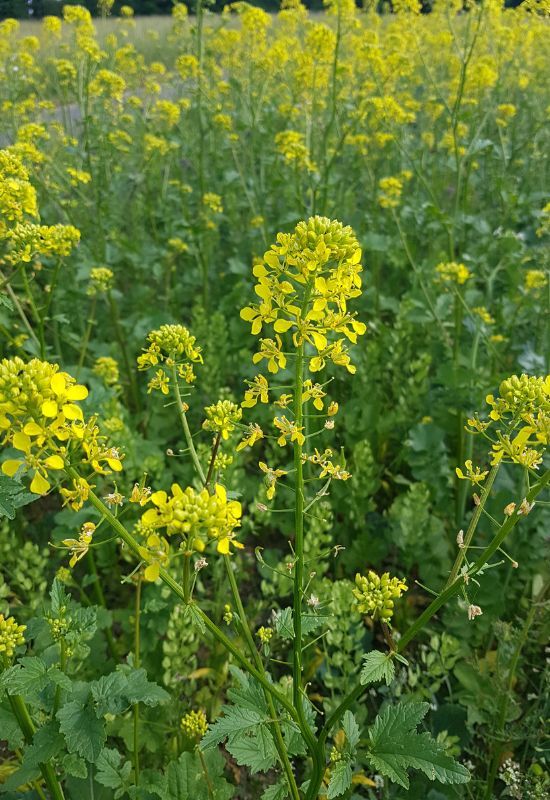
While this seed is perhaps a little more difficult to source, it will be well worth your while to grow some mustard as a cover crop in your raised bed.
In agriculture, mustard is often grown as a biofumigant, and this property can be applied to your raised bed, too. Mustard releases glucosinolates, which suppress fungi and bad nematodes in your soil. For maximum results, incorporate mustard into the soil when it is flowering, but it will still benefit your soil when dug under any time.
However, make sure your mustard does not go to seed. It is a prodigious self seeder, and you will be fighting mustard in your garden for years.
Mustard is best sown in the spring as it grows best in moist environments. Otherwise, plant it in the fall if your season is long enough. Its meter-long (3-foot) taproot will loosen compacted beds, and help stabilize the soil and prevent erosion.
Conclusion
As our glorious summer flowers fade and we pick the last vegetables from the garden, the sad truth is that we have just stripped the soil and left it a little less fertile than it was in the spring.
But the end of the year doesn’t have to be a bleak prospect, and we can rebuild the Earth with careful natural management. Cover crops are a great way to build the soil, and they can be easily worked into a raised bed, or ground-level garden.
Let us know how cover crops work in your raised bed.

Written By
Amber Noyes
Amber Noyes was born and raised in a suburban California town, San Mateo. She holds a master’s degree in horticulture from the University of California as well as a BS in Biology from the University of San Francisco. With experience working on an organic farm, water conservation research, farmers’ markets, and plant nursery, she understands what makes plants thrive and how we can better understand the connection between microclimate and plant health. When she’s not on the land, Amber loves informing people of new ideas/things related to gardening, especially organic gardening, houseplants, and growing plants in a small space.
